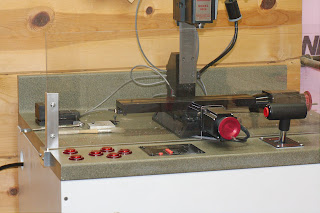No. This was different. This guy grinds his own optics. I didn't see any mirrors he made but I wouldn't be surprised if he could do that, too.
Anyway, he squared up a large piece of stock of mine to be made into a tooling plate. I'll get to that in another post. He also gave me some vinyl from a shower pan liner or something. He suggested I use it to make way and screw covers. The Y-axis is pretty exposed on the Sherline so I thought I'd give it a try.
The front side of the machine is easy. It's "open ended" so easy enough to add mounting material to hold the cover. Here's a shot of the front piece I made:
I used this huge piece of Corian solid-surface counter top for the material. It's plastic. It's machines pretty nicely although it gets a little stinky if it heats up too much. It doesn't look very good, however. It's kind of poor simulation of granite or something. So I just painted it with a flat black and buffed it a bit. It fits right in with the anodized black aluminum of the machine. Ok, the piece I made has the 3 screws on top. Of course I used my hot glue gun to mount it.
Here's the first of three attempts to design a mount for the rear. The challenge with the rear is that anything attached to the rear reduces the range of motion. Above I added the mounting pieces outside the rear column. Theoretically the cover would fold up on itself once and compress against the column costing only 80 mils of Y-travel. I attached the vinyl sheet so it folded up against the table. This resulted in the vinyl arching down against the screw. As the table moved to the rear, the downward bow became strong enough to stall the stepper motor.
Here's the third attempt:
The second attempt had no support in the middle and the vinyl dipped down creating a path for swarf right down to the screw/way. The third design is just one piece with a thin bridge to provide support. So I'm losing about 1/4" of travel at the rear.
Here it is with both covers in place:
And an engraving operation with the covers doing their job:
(Yes, that's a drill chuck. Yes, I know I'm not supposed to use it for milling, but I bought a Dremel engraving kit assuming the shanks were all 1/8". Turned out half of them are 3/32" and I don't have a collet that size. This is a pretty light engraving cut so it should be OK.)













































